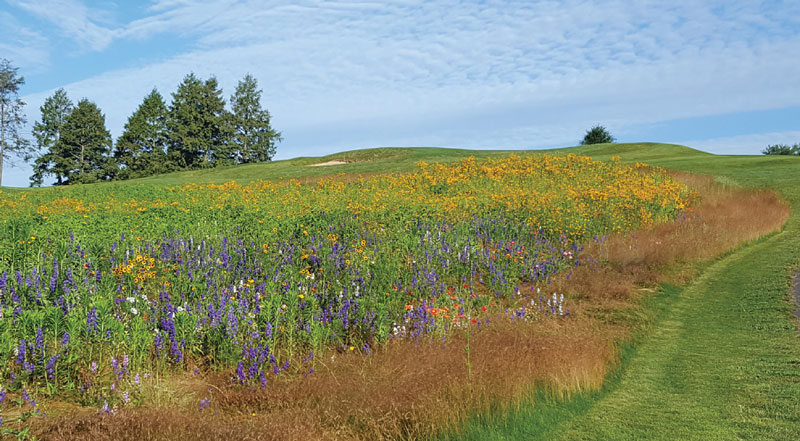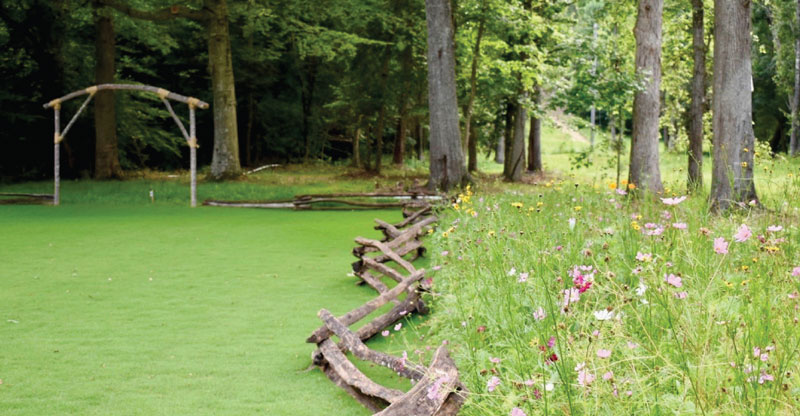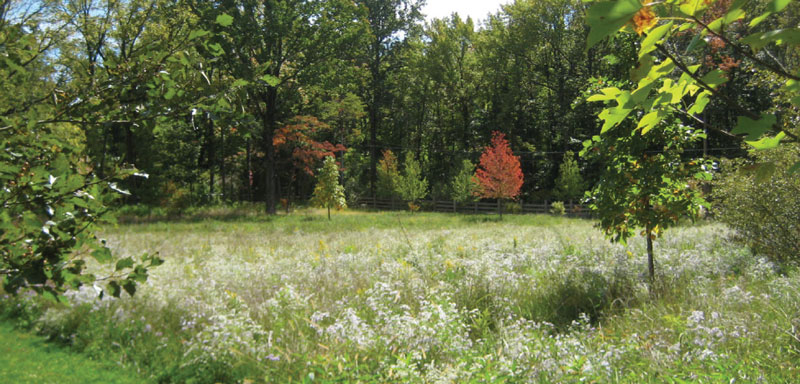The topsoil layer may be thin and subject to drought. If yours is a sandy site, refer to the Southeastern U.S. Sites Guide. Upland examples: Naturally rocky soil subject to erosion or steep road cuts. Meadow examples: Abandoned farm fields, lawns, vacant land, or roadsides.
If the site was previously a lawn or crop field to which herbicides were applied, it is important to allow the appropriate time interval for the herbicide residues to break down prior to planting. Some herbicide residues can prevent seedlings from germinating.

Competition from invasive or undesirable vegetation is the most limiting factor for a successful upland meadow establishment. Prior to planting, all such vegetation must be fully controlled. Typical control strategies include repeated tilling, smothering with black plastic, or herbicides. While any of these methods may control existing weeds, they will not kill all weed seeds lying dormant in the soil. Seeds of such species as velvetleaf and pokeweed may germinate many decades after the species last flowered on the site.
When using the tillage strategy, a site is disc harrowed every two to four weeks for one to two months. The underlying principle of this process is that the root system of perennial species will be worn out to the point of killing the species. In addition, tillage will stimulate germination of some dormant weed seeds that will be killed with subsequent tillage. Planting should not occur until perennial species are completely killed.
Black plastic may also be used to kill weeds. It may be laid across tilled or untilled soil and anchored down by burying the edges in soil or laying boards or bricks across the surface. This strategy should be utilized in a growing season when the intent is to fall plant in the same year or spring plant the following year. This is an example of organic site preparation; for more information on preparing your site organically, consider reviewing The Xerces Society Guide to Organic Site Preparation for Wildflower Establishment.
Use of an approved herbicide, such as glyphosate (Roundup® or Rodeo®), by a licensed spray technician is the most common and least time-intensive method for controlling existing vegetation. Since herbicides are most effective on actively growing plant tissues, they are very effective on new spring growth. Spraying should begin when growth reaches 6”. A follow-up application one to two weeks later will address skips or persistent species. If substantial plant tissue remains on the surface following a full kill by herbicides, close mowing, tillage, or burning may be necessary to achieve good seed-to-soil contact.
Problem weeds should be hand pulled in annual wildflower mixes or annual & perennial wildflower mixes. For all other mixes, see below.
Whenever canopy height (overall vegetation) reaches 18”-24”, trim the meadow to 8” using a brush hog mower or string trimmer. Trimming reduces competition by fast-growing weeds for sunlight, water, and nutrients needed by slower growing perennial natives. A lawn mower is not recommended as the mower height will be too low and native seedlings will be killed. Trimming should cease by mid-September.
Problem weeds should be hand pulled or spot sprayed with an approved herbicide, such as Roundup®, Rodeo®, Garlon®, Garlon® 3A, Stinger®, or Milestone®. Be vigilant in controlling vines or spiny plants if they were not part of the mix. These are more easily pulled early than after two to three months of growth. Examples include bindweed, blackberry, multiflora rose, mile-a-minute, and Japanese hops. Be equally vigilant in the control of other invasive species, such as autumn olive, Canada thistle, and mugwort.
Prior to new spring growth reaching 2” (e.g., shortly after forsythia or redbud blooms), trim any remaining material from the previous year close to the ground (approximately 2”). This will allow the soil to warm more quickly, stimulating emergence and growth of native seedlings and reducing the likelihood of shrub invasion.
Problem weeds should be hand pulled or spot sprayed with an approved herbicide, such as Roundup®, Rodeo®, Garlon®, Garlon® 3A, Stinger®, or Milestone®. Be vigilant in controlling vines or spiny plants if they were not part of the mix.These are more easily pulled early than after two to three months of growth. Examples include bindweed, blackberry, multiflora rose, mile-a-minute, and Japanese hops. Be equally vigilant in the control of other invasive species, such as autumn olive, Canada thistle, and mugwort.

If there is a heavy infestation of ragweed or foxtail in the second growing season, trim the meadow to 8”. Trimming should cease by mid-September. To prevent weed reinfestation, use of an appropriate selective herbicide in conjunction with a seed mix tolerant of that herbicide may be necessary.

Find more seeds and seed mixes like these using the advanced search and filtering options of our Seed Finder Tool.
DISCLAIMER: The information in this review of practices is the result of more than 50 years of experience in seed production. Ernst Conservation Seeds has been supplying seeds and consulting in the reseeding of tens of thousands of acres of roadsides, surface mined lands, conservation, and restoration sites in eastern North America, as well as growing and supplying seed and consulting in the planting of hundreds of thousands of acres of CRP/CREP-related areas for erosion control and wildlife habitat. All of these practices are opinion only and our best advice as a result of these experiences. These recommendations do not cover all the conditions that will be encountered in the field. All of the information is for individual consideration. Ernst Conservation Seeds is not responsible for conditions that will be encountered in individual situations. The use of brand names does not represent our endorsement of a specific product; rather, it represents our experience only and has not necessarily been replicated in peer-reviewed research. The use of chemical pest control agents is subject to manufacturers’ instructions and labeling, as well as federal, state, and local regulations.
Ernst Conservation Seeds
8884 Mercer Pike
Meadville, PA 16335
(800) 873-3321
sales@ernstseed.com
© 2025 Ernst Conservation Seeds | Privacy Policy